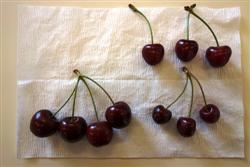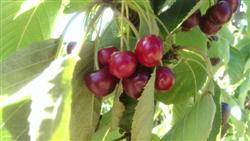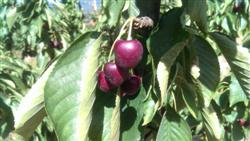
Little cherry disease

Current situation
1 June 2015
Little cherry disease has now been detected in New South Wales, Tasmania and Victoria. These detections include older trees, indicating that little cherry disease has been present in Australia for a substantial period of time.
Notifiable status
Little cherry disease is not a notifiable plant disease in NSW.
A full list of notifiable plant pests and diseases can be found in Schedule 2 of the NSW Biosecurity Act 2015.
Description
Litlle cherry disease is caused by little cherry virus 1 and little cherry virus 2.
Cherry trees infected with little cherry disease produce fruit which is smaller than normal (Figure 1), has a dropped shoulder shape, is poorly coloured (Figure 3) and lacks flavour.
Overseas experience indicates that fruit symptoms vary in severity for all cultivars from season to season and from region to region. In cultivars with red or yellow fruit, symptoms are milder than in dark fruited cultivars.
The fruit of sensitive cultivars may develop normally at first but about 10 days before being ready to harvest they stop maturing.
Leaf symptoms may be seen in some sweet cherry cultivars such as Bing. Leaf colouration is a less reliable symptom than fruit symptoms.
Leaf symptoms may appear in late summer or early autumn. The interveinal areas of the upper leaf surface turns a red-violet or bronze colour while the midrib and main veins retain their green colour. Discolouration is more likely to appear on the basal leaves of the current season’s growth (Figure 2).
Little cherry disease symptoms vary with rootstock and variety combinations. Seasonal conditions affect the severity of little cherry disease symptoms.
Poor tree growth, water logging or nutrient deficiency may mask that a cherry tree has little cherry disease.

Hosts
Little cherry disease affects sweet cherry (Prunus avium) and sour cherry (Prunus cerasus).
Ornamental cherry species especially cultivars of the oriental flowering cherry (Prunus serrulata) may be infected but are symptomless.
Distribution
Little cherry disease is thought to have originated from Japan and has spread to Australia, Europe, and North America.
Within Australia, little cherry disease has been detected in New South Wales, Tasmania and Victoria.
Spread
Little cherry disease is readily transmissible by grafting from any part of an infected tree because virus particles are distributed throughout an infected tree.
Long distance spread of little cherry disease occurs through the movement of infected young trees, rootstocks, scions and budwood.
Little cherry disease is not transmitted by seed.
In North America little cherry disease is vectored by apple mealybug (Phenacoccus aceris) and grape mealybug (Pseudococcus martimus). These two mealybugs are not found in Australia.
Management

There is no cure for Little cherry disease. Once you notice Little cherry disease symptoms the whole tree is infected.
Infected trees are never as productive as healthy trees and symptoms get worse the longer the tree is infected. Infected trees should be removed. The best method for removal involves cutting trees at the stump and applying poison to kill the root system that remains.
Propagation material should be of high health status and certified as known virus tested.
Actions to minimise risks
Put in place biosecurity best practice actions to prevent entry, establishment and spread of pests and diseases:
- practice “Come clean, Go clean”
- ensure all staff and visitors are instructed in and adhere to your business management hygiene requirements
- source propagation material that is certified as known virus tested
- monitor your orchard regularly
- keep records

